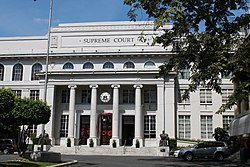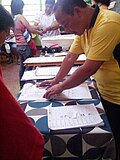Politics of the Philippines
Politics Of The Philippines Media
The 1935 Constitution of the Philippines, which served as the basis for the current constitution
Voting lines in Mabalacat during the 2013 elections
Electoral official in Valencia checking an electoral roll during the 2013 elections
Protests against the Reproductive Health Act of 2012 (RH Bill)
The 2003 Oakwood mutiny and 2007 Manila Peninsula siege saw prominent buildings in Makati occupied by military forces in opposition to the Gloria Macapagal Arroyo administration.
Philippine President Ferdinand Marcos, American President Ronald Reagan, and Imelda Marcos during a Philippine state visit to the United States
The Spanish established Manila as the capital of the Captaincy General of the Philippines.
Politics of the Philippines are ruled over by a three-branch structure of government. The Philippines is a democracy, with a president who is voted by people in elections and serves as both the head of state and the head of government.
The president is the leader of the executive branch and is a powerful politician; but can only have one six-year term.
The bicameral Congress contains two separate bodies:
- Senate, with members voted all around the country, and larger House of Representatives, with members chosen mostly from a particular geographic area.
- Judiciary, overseen by the Supreme Court of the Philippines, and has thorough review jurisdictions over reasons provided by other governmental and administrative institutions.
Spain and United States' prior ruling impacted heavily on the legal system; covering civil and criminal law. It resulted in a elite-dominated system. Following the Spanish–American War, the US took power of the whole archipelago, which restrained the Philippine Revolution that continued after the Spanish administration. The US, constructed after the US political system, resulted in democracy and institutions. Martial law's implementation obstructed this. National politics were ruled by a two-party system when the country took independence during 1946 and changes brought about by the repairing of democracy that led into the multi-party system that still is present today.
Election in the Philippines
Every three years, an election is held, although the president, vice-president, and Senators are elected for six-year terms. The results are thought about through to first-past-the-post voting, including a winner-take-all voting method for the elections such as the Senate.








